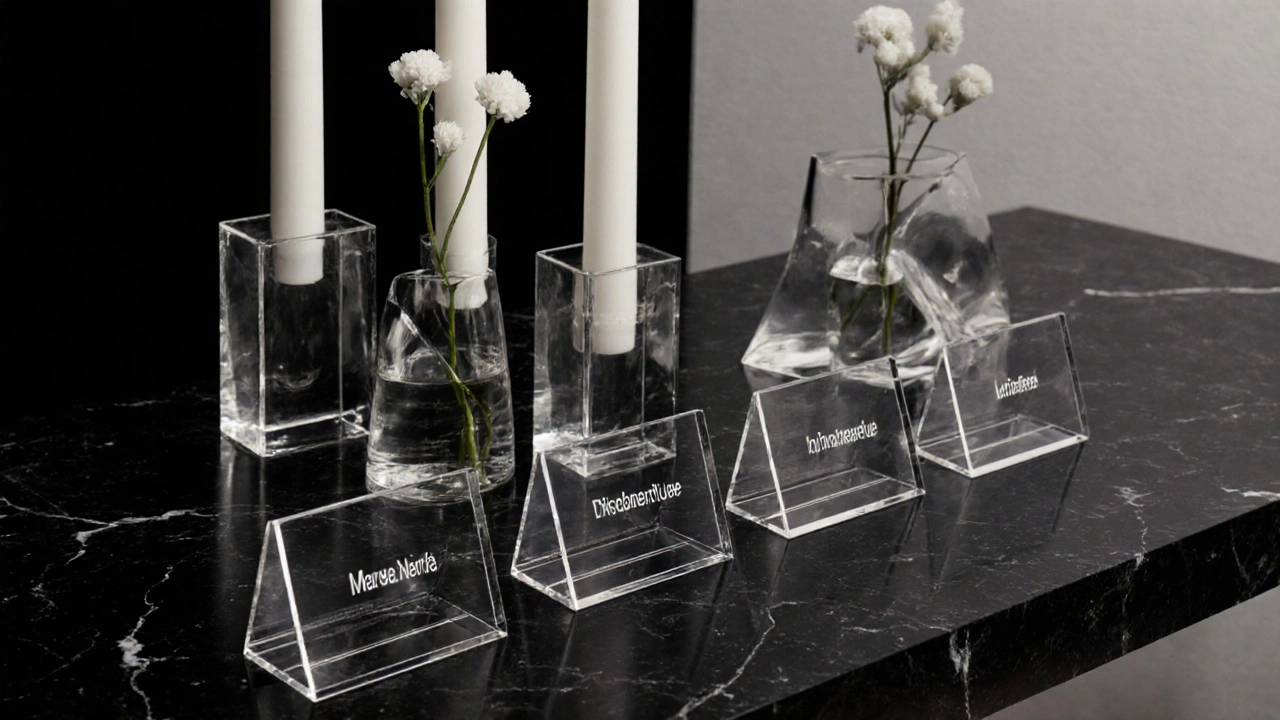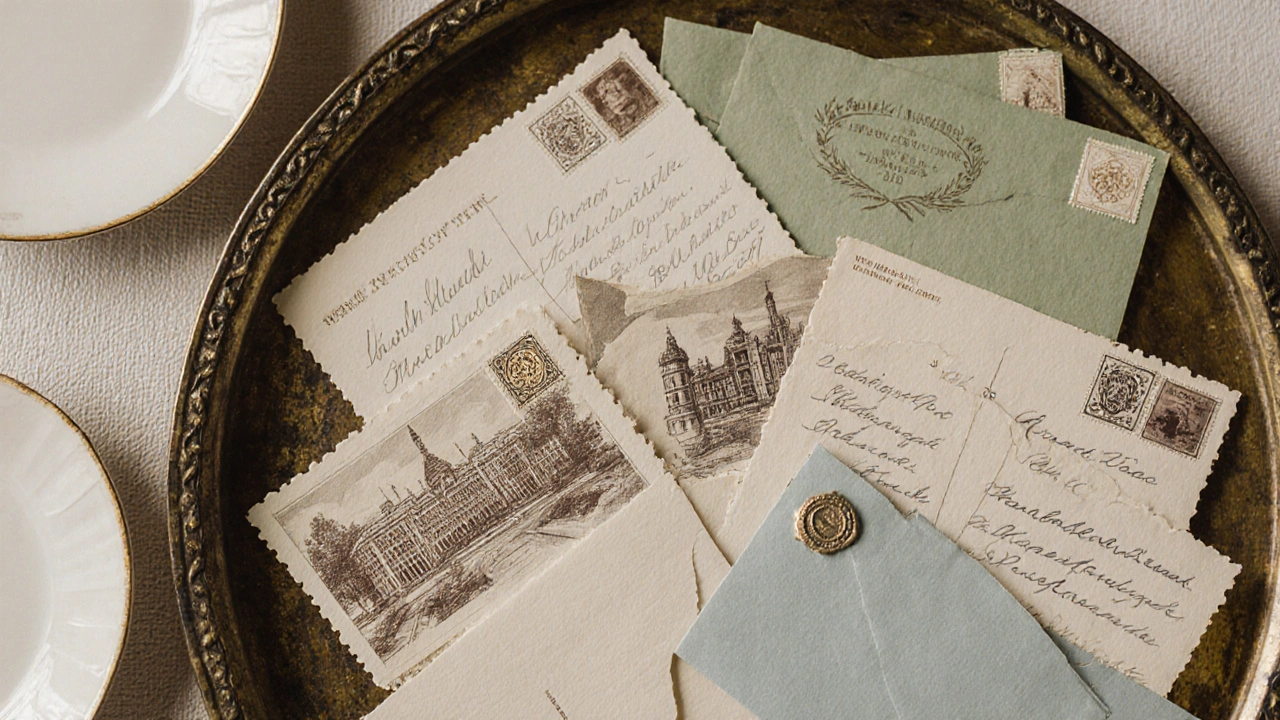Wedding escort cards aren’t just functional-they’re the first real taste of your big day’s vibe. If you’re planning a rustic, modern, or vintage wedding, your escort cards should match the mood, not just point people to their tables. Too often, couples treat them as an afterthought. But when done right, they become a keepsake, not just a signpost.
Rustic Escort Cards That Feel Like a Country Porch
Rustic weddings aren’t just about burlap and mason jars. They’re about texture, warmth, and things that look like they’ve been around for a while. For escort cards, think natural materials that age gracefully. Wooden slices, cut from reclaimed barn wood, work beautifully. Sand them lightly, stain them with a soft walnut tone, and write names in dark ink with a fine-tip pen. Tie each one with a thin piece of twine and tuck it into a small burlap pouch or rest it on a stack of vintage books.Another favorite: handwritten notes on thick, uncoated paper that looks like it came from a 1920s ledger. Use a calligraphy nib and iron-gall ink for that authentic, slightly faded look. Arrange them in a wooden crate lined with dried lavender or eucalyptus. Guests don’t just find their table-they feel like they’ve stepped into a farmhouse kitchen.
Pro tip: Skip the printed labels. Handwriting adds soul. Even if your handwriting isn’t perfect, it’s real. And real matters more than perfect at a rustic wedding.
Modern Escort Cards: Clean, Bold, and Intentional
Modern weddings strip away the fluff. Think sharp lines, monochrome palettes, and materials that feel intentional. For escort cards, this means sleek surfaces and minimalist design. Acrylic is the go-to. Thin, clear acrylic rectangles (about 3x5 inches) with names laser-engraved in a crisp sans-serif font like Futura or Helvetica Neue. No borders. No flourishes. Just the name and table number-centered, perfectly aligned.Some couples use metallic foil on matte black cardstock. Gold, rose gold, or even copper. The contrast is striking. Lay them flat on a long, narrow table with a single line of white candles or a row of geometric glass vases holding one stem each.
For the tech-savvy couple, digital escort cards are gaining traction. A QR code on a small, matte card links to a simple web page showing seating. No paper waste. No last-minute changes. Just scan and go. But even here, the design must be clean. No clutter. No animated graphics. If you go digital, make sure the page loads fast and works offline.
Vintage Escort Cards: Nostalgia You Can Hold
Vintage doesn’t mean old. It means timeless. Think 1940s elegance, 1970s boho, or early 1900s romance. For escort cards, texture and detail matter more than color. Use recycled paper with visible fibers-like cotton rag stock-and edge it with a gold or copper stamp. Hand-stamp each card with a small floral or art deco motif using a rubber stamp and archival ink.Another popular look: small postcards. Print names on vintage-style postcards (available from specialty stationers) with a sepia-toned photo of your venue or a classic illustration. Guests can keep them as mementos. Tuck them into envelopes sealed with wax-use a simple monogram or a tiny flower stamp. Drop them into a vintage brass tray or a porcelain dish from a thrift store.
Don’t forget the envelope. A mismatched set of vintage envelopes adds charm. Use different sizes, colors, and textures. A mix of cream, sage, and pale blue envelopes with hand-addressed names in matching ink creates a curated, collected feel. No two are alike-and that’s the point.

How to Match Your Cards to Your Venue
Your escort cards should feel like they belong where they’re placed. If you’re having a barn wedding, don’t put sleek acrylic cards on a wooden table. They’ll look out of place. If you’re in a concrete loft with steel beams, avoid delicate lace paper-it’ll look fragile, not refined.For a garden wedding, use botanical-themed cards printed on recycled paper with seed paper edges. After the wedding, guests can plant them. For a ballroom, go for velvet-backed cards with gold foil lettering. For a beach wedding, use weathered driftwood tags tied with jute and sprayed lightly with saltwater to give them that sun-bleached look.
The key? Don’t force a theme. Let your venue guide the material. A stone chapel calls for something heavy and textured. A glass-walled penthouse asks for something light and transparent.
What Not to Do
Avoid these common mistakes:- Using tiny cards that are hard to read from a distance
- Printing names in light gray or pastel ink on white paper-guests squint, and photos look washed out
- Putting escort cards on tables before guests arrive-this creates confusion. Place them on a dedicated display table near the entrance
- Using fonts that are too fancy or script-heavy-legibility beats style
- Forgetting to include table numbers clearly
Also, don’t try to match every single detail. If your invitations are vintage and your escort cards are modern, that’s fine. Cohesion doesn’t mean sameness. It means harmony.

DIY vs. Professional: What Works Best
If you’re crafting 100+ escort cards by hand, you’re not just saving money-you’re investing time. For rustic or vintage styles, DIY works. You can buy bulk wooden slices, uncoated paper, and stamps online for under $100. But if you’re doing 150 acrylic cards with laser engraving? That’s a job for a pro. Expect to pay $2-$4 per card, depending on design complexity.Professional designers bring consistency. They know ink won’t smudge, paper won’t warp, and fonts won’t pixelate when printed small. If your wedding has a tight timeline or you’re not confident in your crafting skills, hire someone. It’s not a luxury-it’s insurance.
Hybrid option: Design the layout yourself, then outsource printing. Use Canva or Adobe Express to create the template, then upload it to a service like Minted or Paper Source. They handle the printing, cutting, and even assembly.
Final Touch: The Display
Where you place your escort cards matters as much as how they look. Don’t just stick them on a table. Create a moment. Use a vintage ladder to hang cards on clips. Arrange them like a gallery on a long wooden board. Stack them in a wooden crate with a chalkboard sign that says, “Find Your Table.”Add a small sign with a friendly note: “Your name is here. Take your time. We’re glad you’re here.” It turns a functional task into a warm welcome.
And remember: Your guests won’t remember every detail. But they’ll remember how it felt. A well-designed escort card says, “We thought about you.” And that’s what lasts.
What’s the best material for rustic escort cards?
Wooden slices, especially reclaimed barn wood, are ideal. They’re natural, textured, and hold ink well. Uncoated paper with visible fibers also works, especially if you want a handwritten feel. Avoid glossy paper-it clashes with the rustic aesthetic.
Can I use digital escort cards for a vintage wedding?
It’s possible, but it’s risky. Vintage weddings thrive on tactile details-wax seals, handwritten notes, aged paper. A QR code feels too modern unless you design it to look vintage-think sepia tones, typewriter fonts, and a retro border. Even then, many guests prefer something they can hold.
How many escort cards do I need?
One per guest. Don’t count children under 5 unless they’re seated at a kids’ table. If you’re doing assigned seating, make sure every adult has a card. If you’re doing open seating, you can skip them-but most couples still use them for atmosphere.
When should I order escort cards?
Order at least 6-8 weeks before your wedding. If you’re doing DIY, give yourself 3-4 weeks to assemble. Professional printers need 4-6 weeks for production and shipping. Rush orders are possible but cost more and may compromise quality.
Are escort cards necessary for a small wedding?
Not strictly, but they add polish. Even with 30 guests, a thoughtful display makes the event feel intentional. It shows you cared about the details. Skip them only if you’re going for a completely casual, no-frills vibe.
